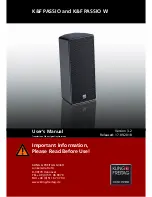
THE BOUNDARY EFFECT
Placing a speaker in a corner can powerfully affect the way a listener perceives bass response.
Known as the boundary effect, placing speakers close to a wall/ceiling boundary or near a corner-
wall boundary will emphasize certain bass frequencies while canceling others. This effect can
make the speaker sound excessively boomy and inaccurate to some listeners, while to others it
just seems like more bass sound.
As a good rule-of-thumb, if you like listening to your current pair of speakers with the bass turned
up, you’ll enjoy corner placement. However, if you listen with the tone controls at neutral, try keep-
ing the speakers at least 2 or 3 feet from the boundaries of the room.
USING THE DIRECT RADIATING/DIFFUSE FIELD
SELECTOR SWITCH
If the listener prefers a more diffuse sound field, set the DIRECT/DIFFUSE switch to the DIFFUSE
position, as shown in
Figure 6
. The DIFFUSE setting provides less localization of the sound and
a more spacious feel. Make sure to align the speakers so the “out-of-phase” tweeters (identified
by a gray dot) are oriented in the same direction, relative to the listener. If desired, experiment with
tweeter orientation to give the most pleasant sound for your particular installation.
If the listener prefers a more direct sound field, set the DIRECT/DIFFUSE switch to the DIRECT
position, as shown in
Figure 7
. The DIRECT setting provides more localization of sound and
creates a more dramatic surround effect. If desired, experiment with tweeter orientation to give
the most pleasant sound for your particular installation.
Figure 6.
The
CM6HDfx DIRECT/
DIFFUSE switch is set
to DIFFUSE for a more
spacious sound field.
Figure 7.
The
CM6HDfx DIRECT/
DIFFUSE switch is set
to DIRECT for a more
dramatic sound field.
8
-3dB
0dB
TWEETER
LEVEL
DIFFUSE
DIRECT
-3dB
0dB
TWEETER
LEVEL
DIFFUSE
DIRECT
-3dB
0dB
TWEETER
LEVEL
DIFFUSE
DIRECT
-3dB
0dB
TWEETER
LEVEL
DIFFUSE
DIRECT










































